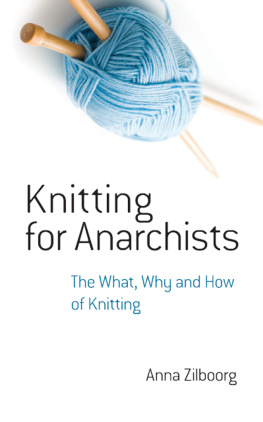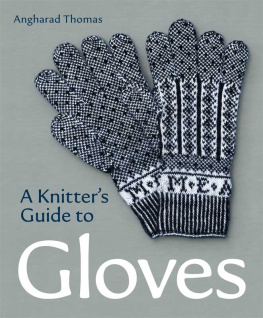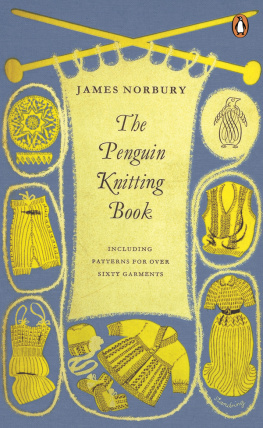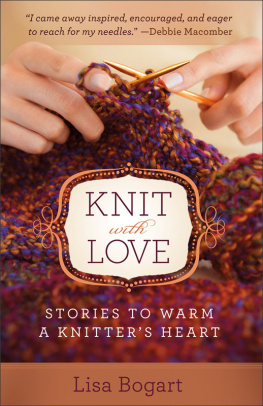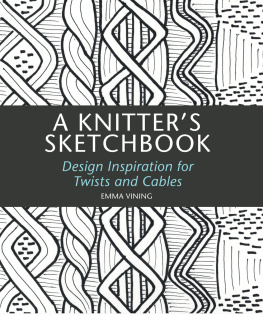
Create your own using the general directions of .
Detailed directions in .
Detailed directions in .
Knitting for Anarchists
The What, Why and How of Knitting
Anna Zilboorg
Dover Publications, Inc.
Mineola, New York
Copyright
Copyright 2002 by Anna Zilboorg
All rights reserved.
Bibliographical Note
Knitting for Anarchists: The What, Why and How of Knitting, fi rst published by Dover Publications, Inc., in 2015, is an unabridged republication of Knitting for Anarchists, originally published by Unicorn Books, Petaluma, California, in 2002. The color plates from the interior of the book have been reproduced on the inside covers in this edition.
Library of Congress Cataloging-in-Publication Data
Zilboorg, Anna, 1933
Knitting for anarchists / Anna Zilboorg.
pages cm
Originally published by Unicorn Books, Petaluma, California, in 2002.
eISBN-13: 978-0-486-80192-6
1. Knitting. 2. SweatersDesign. I. Title.
TT820.Z537 2015
746.432dc23
2014038502
Manufactured in the United States by Courier Corporation
79466001 2015
www.doverpublications.com
to Jeff
an anarchist with an eye for excellence wherever it appears
We can do no great things for God, only small things with great love.
- Mother Teresa
ACKNOWLEDGEMENTS
T HIS BOOK HAS BEEN a long time in coming. My tendency toward sloth and self-indulgence (Id much rather knit than write) has hampered its completion. Indeed, without the goading and encouragement of others, it would never have been done. I am grateful, therefore, to all my friends, colleagues and students who have urged me onward.
I especially want to thank Elaine Rowley, who told me years ago that I should write about knitting, and has continued to nudge and encourage.
And my thanks to Mary K. Wakeman, proofreader par excellence, and to Mary Dashiell for always willing help.
Without Merike Saarniit this book could have been disastrous. She read and reread, tested out directions, critiqued when called for, and proofread one more time. I am awed by such devotion to a gruesome task.
Finally, there is David Oliversine qua non.
KNITTING FOR ANARCHISTS
anarchism: 3. Rejection of all forms of coercive control and authority
- American Heritage Dictionary
M OST ANARCHISTS ARE GENTLE people. They see that government is the major source of violence in the world since governments get into wars, and that wars make people do monstrous things that they would otherwise never do. So they want to get rid of government. They see that the greatest source of oppression is greed and ownership of the sources of wealth, so they want the means of production owned by those who do the producing. They yearn to see the organizations of society grow from shared interests and mutual benefitsa constant coming together and moving apart so that no firm structure becomes established that could become oppressive. Its straightforward idealistic stuff.
The great desire of anarchism is for all people to live in peace, following their own stars. We may not be able to accomplish that in the world at large, reality being as it is, but we might well attain that ideal in the world of knitting. We do not need to be ruled by fashion in deciding what to make. We do not need to be cowed by professional decrees of the right and wrong way to do things. We do not need to be fearful of trying out ideas, of making mistakes and thereby learning, of creating something new and wonderful, or of just pleasing our own selves and nobody else. Anarchism is an excellent ideology for knitters, as I hope this small treatise will show. If I fail to win any to the cause, no matter. The I.W.W. (Industrial Workers of the World, familiarly known as wobblies) advises: organize on the issues, not on the ideology. It is the issues I mean to address. If we take control of our knitting and do with it what we like, we have nothing to lose but our chains and we have a world to gain.
In this book I intend to explain to knitters why they do what they do, and how to do it simply. In knitting, more than in many areas, understanding gives us power. Through understanding we become able to control our knitting and make it do what we want. Without understanding, we are doomed to do what we are told. Anarchists generally do not like to do what they are told.
Most people learn to knit by rote. That is, they are told or shown exactly what to do with their hands and yarn and needles, step by step. At first doing it is extremely awkward. Then it gets easier. Hands learn things far more slowly than minds do. You tell your fingers what to do and expect instant obedience, but it takes a while for fingers to figure out just how to obey. Once they learn, they find it difficult to change, as anyone knows who has switched from English to Continental knitting. (I know of no one who has gone the other way.) Many people, trying to get their hands to do what directions tell them, give up in frustration saying they dont have the patience or are too clumsy to do that. Im always sorry when I hear that. I know hands are endlessly capable of wonderful feats, but they need patience and encouragement.
In addition to patience and encouragement, hands need to be allowed flexibility. Your hands may just not want to wrap the yarn the way your teacherbook, person, video or whateveris telling you to do it. They may have a better way, for them, of tensioning the yarn or getting it around the needle. I expect that many more people would knit, and knit with great enjoyment, if they could allow their hands to be partners in the process of learning instead of ordering their hands around like slaves. (What self-respecting hands would not revolt?) My theory is supported by the experience of enthusiastic knitters. When you look at what knitters hands are actually doing, you see a great variety of styles of knitting. Elaine Rowley of Knitters fame, once said shed like to make a video of many hands and styles of knitting. It would show how the same thing can be accomplished in an amazing variety of ways. Once, when I asked students whether they knitted English or Continental, someone said she didnt know. I inwardly groaned, thinking I had a real beginner in what was a fairly advanced class, but she showed me how she knit. Sure enough, it was a hybrid style, carrying the yarn in her left hand and throwing in with her right. She knit beautifully.
The fact is, when people knit for a while they stop thinking about the book and the right way to do it and let their hands take over. Then they become real knitters. Once their hands know how to do whatever needs to be done, their heads begin to catch up. They begin paying attention to the fabric that is appearing under their hands. Their knitting naturally becomes their craft and they gain some understanding of it.
Some think more; some less. I have thought about my knitting for many years. Teaching workshops has caused me to think a great deal more because of the challenge of trying to explain things to people whose minds, as well as fingers, may work very differently from mine. Also, writing directions has brought into sharp focus for me many problems of both understanding and communication.
With this background, I have compiled explanations, speculations, exhortations and some highly opinionated advice. In addition, I have written a pattern designed to stimulate autonomy and creativity. (Can a pattern do something so contrary to its nature? I hope so.)
The explanations, which are the useful part, do not cover the contents of other books on how to knit. On the contrary, they focus on things that others never seem to talk about, or perhaps think aboutbut things that I have found extremely useful in my own knitting and have found that students in classes are happy to learn. A lot of this explaining is much better done in person with yarn and needles in hand, rather than in writing, but Ive done my best with the limitations of the written word. To make understanding easier, I strongly suggest you keep some knitting nearby to test out what Im writing about. Illustrations, it seems to me, are never quite good enough.
Next page
